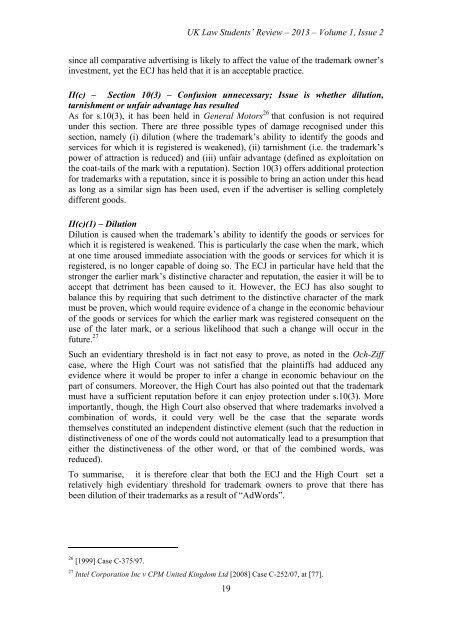Open UKLSR Volume 1(2) - Uklsa
Open UKLSR Volume 1(2) - Uklsa
Open UKLSR Volume 1(2) - Uklsa
You also want an ePaper? Increase the reach of your titles
YUMPU automatically turns print PDFs into web optimized ePapers that Google loves.
UK Law Students’ Review – 2013 – <strong>Volume</strong> 1, Issue 2<br />
since all comparative advertising is likely to affect the value of the trademark owner’s<br />
investment, yet the ECJ has held that it is an acceptable practice.<br />
II(c) – Section 10(3) – Confusion unnecessary; Issue is whether dilution,<br />
tarnishment or unfair advantage has resulted<br />
As for s.10(3), it has been held in General Motors 26 that confusion is not required<br />
under this section. There are three possible types of damage recognised under this<br />
section, namely (i) dilution (where the trademark’s ability to identify the goods and<br />
services for which it is registered is weakened), (ii) tarnishment (i.e. the trademark’s<br />
power of attraction is reduced) and (iii) unfair advantage (defined as exploitation on<br />
the coat-tails of the mark with a reputation). Section 10(3) offers additional protection<br />
for trademarks with a reputation, since it is possible to bring an action under this head<br />
as long as a similar sign has been used, even if the advertiser is selling completely<br />
different goods.<br />
II(c)(1) – Dilution<br />
Dilution is caused when the trademark’s ability to identify the goods or services for<br />
which it is registered is weakened. This is particularly the case when the mark, which<br />
at one time aroused immediate association with the goods or services for which it is<br />
registered, is no longer capable of doing so. The ECJ in particular have held that the<br />
stronger the earlier mark’s distinctive character and reputation, the easier it will be to<br />
accept that detriment has been caused to it. However, the ECJ has also sought to<br />
balance this by requiring that such detriment to the distinctive character of the mark<br />
must be proven, which would require evidence of a change in the economic behaviour<br />
of the goods or services for which the earlier mark was registered consequent on the<br />
use of the later mark, or a serious likelihood that such a change will occur in the<br />
future. 27<br />
Such an evidentiary threshold is in fact not easy to prove, as noted in the Och-Ziff<br />
case, where the High Court was not satisfied that the plaintiffs had adduced any<br />
evidence where it would be proper to infer a change in economic behaviour on the<br />
part of consumers. Moreover, the High Court has also pointed out that the trademark<br />
must have a sufficient reputation before it can enjoy protection under s.10(3). More<br />
importantly, though, the High Court also observed that where trademarks involved a<br />
combination of words, it could very well be the case that the separate words<br />
themselves constituted an independent distinctive element (such that the reduction in<br />
distinctiveness of one of the words could not automatically lead to a presumption that<br />
either the distinctiveness of the other word, or that of the combined words, was<br />
reduced).<br />
To summarise, it is therefore clear that both the ECJ and the High Court set a<br />
relatively high evidentiary threshold for trademark owners to prove that there has<br />
been dilution of their trademarks as a result of “AdWords”.<br />
26 [1999] Case C-375/97.<br />
27 Intel Corporation Inc v CPM United Kingdom Ltd [2008] Case C-252/07, at [77].<br />
19


